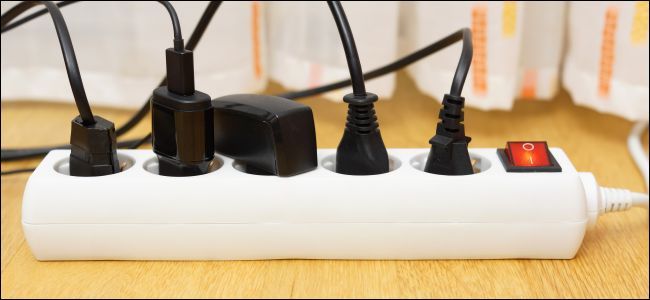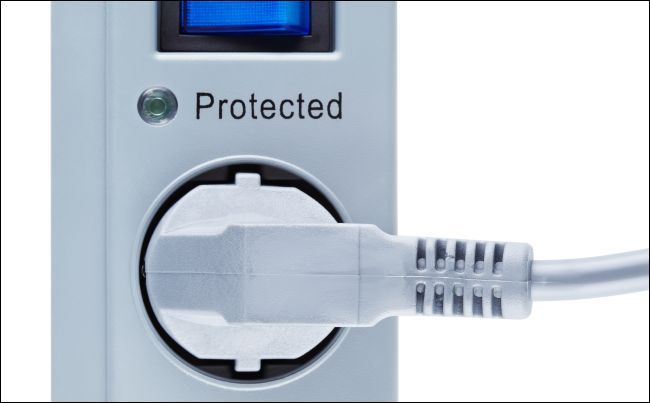Quick Links
Surge protectors often look just like power strips, but not all power strips are surge protectors. Only surge protections actually help protect your gadgets against power surges. Many power strips are just glorified extension cords without any protection. But you can tell whether a strip provides surge protection with just a few seconds of examination.
Not Every Power Strip Provides Surge Protection
A power strip plugs into a wall outlet and offers outlets for multiple devices. But that's all a simple power strip does. It's essentially an extension cord with multiple outlets and no fancy features, although it might have a switch to quickly cut power to all connected devices. Connecting a device to a power strip is just like connecting it to a wall outlet, at least in terms of safety.
A surge protector (sometimes called a "surge suppressor" instead) often comes in the shape of a power strip. Like power strips, most surge protectors plug into a wall outlet and offer outlets for multiple devices. But, surge protectors also have electronics built in that help prevent power surges from damaging connected devices. Connecting a device to a surge protector provides more protection than simply connecting it to a wall outlet.
While common power strips and surge protectors look similar, not all power strips are surge protectors. Surge protectors are a bit more expensive. For example, you might pay $20 for a surge protector, while a similar-looking power strip costs only $10.
When it comes to expensive electronics devices like your TV and home theater system, or your computer and other fancy electronics, using a surge protector is a good idea. But, when you're just plugging in a coffee maker or toaster, a simple power strip is just fine.
While surge protectors often come in power strip shape, they don't always. For example, you can get a single-outlet surge protector that allows you to plug a single device into a single wall outlet, but with surge protection. The power strip design is just more common.
How to Tell the Difference on the Packaging
When shopping for a surge protector at a store, be sure to look for the words "surge protector" or at least "protection" or "suppression." You'll often see power strips and surge protectors near each other in the store, and they can look similar at a glance. The power strips will be cheaper, but read the fine print: Anything that just says "power strip" isn't a surge protector.
Surge protectors are often rated in the amount of Joules of energy they can absorb, so you're likely to see this information clearly advertised on the surge protector. For example, the Belkin surge protector we linked above boasts a 3,940-joule energy rating. When you're looking at ratings, a surge protector rated at 1000-2000 Joules is typically good enough for smaller electronics---networking gear, smartphones, printers, and so on. If you're protecting home theater gear, gaming consoles, or desktop and laptop computers, look for something over 2000 Joules. And if you're protecting multiple large components on a single surge protector, look for an even higher rating.
As long as you know to look for surge protection, the product packaging (or web product listing) makes it easy to avoid plain power strips and find a surge protector.
How to Tell the Difference on the Device
If you have a bunch of power strips lying around and you're not sure whether they're surge protectors or not, you can tell with a quick examination. Surge protectors often (but not always) have a "Protected" or "Protection" light on them that lights up when they're plugged in. This tells you that the surge protector is functional and doesn't need to be replaced.
If you flip the device over and read through the fine print on the back, you may see a "suppressed voltage rating" or similar specification. If you see anything that refers to "protection" or "suppression" on it, the device you have in your hands is a surge protector.
If the surge protector is very old, there's a chance that it no longer functions as a surge protector and needs to be replaced. That's the purpose of the light on new surge protectors, of course. If you see a light that doesn't turn on when the surge protector is connected to an outlet, the surge protector has worn down and it just functions as a power strip with no surge protection.
If you don't see a "protected" light or anything related to protection or suppression printed anywhere on the device, you're holding a simple power strip and not a surge protector. It's fine for your coffee maker, but you probably don't want to hook up your home theater system to it.
And if you're looking for even more protection for your desktop or laptop computer, you might want to consider an uninterruptible power supply (UPS) instead. These also offer surge protection and the ability to plug in multiple devices, but also protect against sudden power loss with a battery backup. They give you the time to save documents and power down your computer gracefully should you lose power.
Image Credit: Bacho/Shutterstock.com


